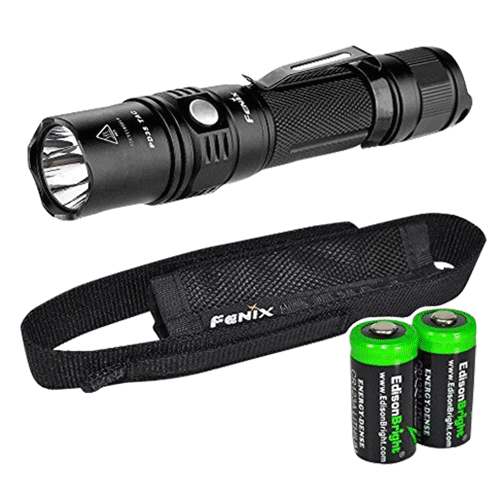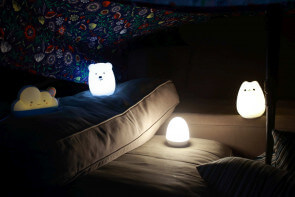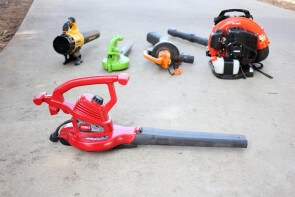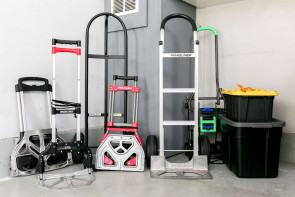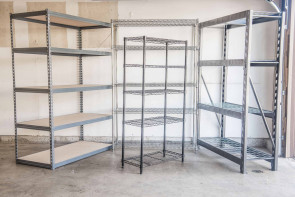
The Best Rechargeable Flashlights
After spending three weeks wandering in poorly lit areas with ten top products that cost under $100, we determined that the Fenix – PD35 Tactical is the best rechargeable flashlight. It outshined the competition, showing a very bright performance from edge to edge. The Fenix features waterproof aircraft aluminum construction and six operating modes. Though not the most compact, the STANLEY – FATMAX searchlight delivered the brightest light in our tests.
After spending three weeks wandering in poorly lit areas with ten top products that cost under $100, we determined that the Fenix – PD35 Tactical is the best rechargeable flashlight. It outshined the competition, showing a very bright performance from edge to edge. The Fenix features waterproof aircraft aluminum construction and six operating modes. Though not the most compact, the STANLEY – FATMAX searchlight delivered the brightest light in our tests.
Table of contents
- How we selected finalists to test
- Compare the best rechargeable flashlights
- What are LED lights?
- Tactical vs. searchlight vs. emergency
- How we tested
- Best overall: Fenix – PD35
- The brightest: STANLEY – FATMAX
- Other finalists we tested
- The bottom line
How we selected finalists to test
Flashlights, also referred to as torches outside the U.S., perform one simple task – providing light! We explore what features distinguish one flashlight to the next by examining design and functionality. We also found it important to cover a variety of rechargeable flashlights to address different applications. There was representation from rechargeable tactical flashlights, search lights and emergency lights.
The hunt for the best rechargeable flashlight began on a variety of outdoor forums and online retailers such as Amazon. We combed through countless consumer reviews and visited several blogs to determine the most important qualities of flashlights. The list of needs are quite simple – quality of light, design and durability. We were able to break down these categories down into more specific categories to help determine the best rechargeable flashlight for your hard-earned buck.
Compare the best rechargeable flashlights
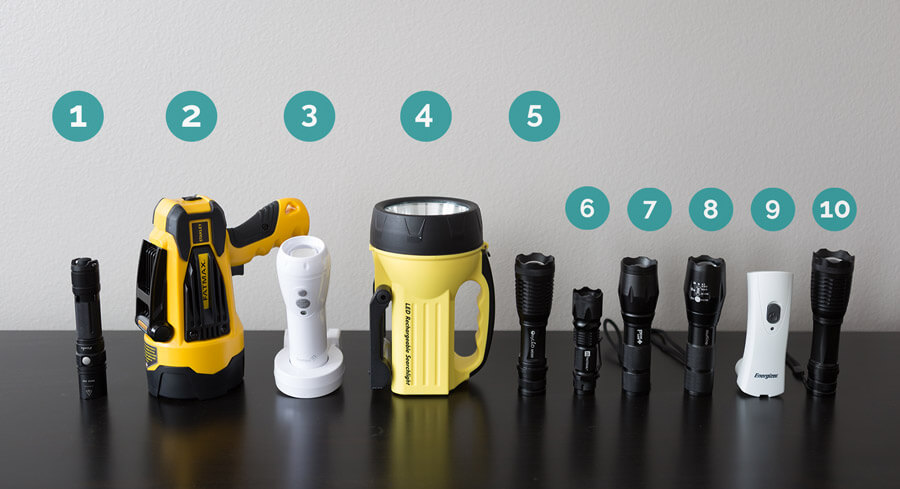
| Product | Price | Light Type | Brightness (Center Lux 3' Away) | Battery Life Rating |
|---|---|---|---|---|
| 1. Fenix - PD35 Tactical | $$$$ | Tactical | 12,100 | ☆☆☆☆☆ |
| 2. STANLEY FATMAX - Spotlight | $$$ | Spotlight | 110,000 | ☆☆☆☆☆ |
| 3. Ivation - IVAEMG55 Emergency | $ | Emergency | 470 | ☆ |
| 4. WASING - WSL-827 Spotlight | $$ | Spotlight | 45,600 | ☆☆☆☆☆ |
| 5. OxyLED - MD50 Tactical | $ | Tactical | 23,500 | ☆☆ |
| 6. J5 - V1-Pro Tactical | $ | Tactical | 7,800 | ☆☆ |
| 7. PeakPlus - Tactical | $$ | Tactical | 15,000 | ☆☆☆☆ |
| 8. Outlite - A100 Tactical | $$ | Tactical | 16,200 | ☆☆☆☆ |
| 9. Energizer - Weatheready Emergency | $ | Emergency | 370 | ☆☆ |
| 10. Refun - E6 Tactical | $ | Tactical | 14,500 | ☆☆ |
What are LED lights?

All of the lights we tested use LED bulbs. To understand the modern day flashlight technology, let’s dive in a little deeper to explore the evolution of LED bulbs.
Before the mid-1990s, flashlights were made with incandescent bulbs, which rely on a filament to be heated to produce light and heat. Unfortunately, this design is highly fragile and susceptible to damage from impact. Dropping or hitting the flashlight against an object would risk breaking the filament.
It’s typical lifespan is about six hours before they would wear down. The appearance of LEDs in flashlights at the turn of millennium was revolutionary and would allow for manufacturers to take their flashlights above and beyond.
LEDs produce light electronically by changing an energy state while producing very little heat. One of the biggest improvements is their improved lifespan of around 11 years of continuous light. LEDs are also much more gracious with battery drain compared to the old technology. The LEDs are encapsulated in clear epoxy and are shockproof so you can drop them without worry. Finally, LEDs generally produce a white light, which is much more similar to daylight.
The emergence of LEDs was the perfect technology for the flashlight industry — small form factor, reliable bright light and low energy consumption. It allowed manufacturers to create more dependable products, which ultimately improves your quality of life.
Tactical vs. searchlight vs. emergency

Tactical lights
The word “tactical” implies actionable military grade use or careful professional planning. An example of this is our top overall pick shown in the photo above, the Fenix PD35.
Tactical flashlights were originally designed for military and law enforcement and are to be used alongside handheld weapons or mounted on a gun. The light is used for illuminating dark areas and blinding opponents as well. They are generally built with “aerospace grade aluminum,” which is a buzzword for “aluminum alloy.” It will hold very well against scratches, drops and other forms of impact.
Tactical lights have textured grips and feature an anti-roll profile, while being small enough to fit in a pocket. Their reputation has earned them a spot in the hands of a much broader audience. Now many average consumers and professionals have adopted tactical lights into their tool belt. If you want to buy a great tactical light, check out our review of the best ones.
Searchlights
Historically, searchlights / spotlights were large powerful devices used in the military to assist with attacks, detect enemy ships at great distances and for defense against nighttime bomber raids.
The searchlights we looked at in our tests are less dramatic, but hang on to similar design cues in it’s relatively larger body and light reflector. You can see an example of one we tested, the large, yellow STANLEY FATMAX.
If tactical flashlights were racecars, searchlights would be minivans — huskier, maybe not as cool, but might be the right one for the job! It’s large frame often include a handle for better grip. If you need a bright wide light and don’t mind the bulk, searchlights may be the best option. It would be suitable for outdoor hobbies or search parties, where light strength takes priority.
Emergency lights
Of course, any light can be used in the case of an emergency, but emergency lights are marketed as reliable, easy to use and easy to find. They use less elaborate materials compared to tactical flashlights and are typically plugged into a wall outlet to ensure an always-ready device. Having an emergency light fixed to a spot on the wall makes it easier to remember where it is, as opposed to losing it in a dark tool drawer.
An example of one that stood out to us was the Ivation emergency light which also functions as a night light. We have an in-depth review of night lights too, if you’re looking for a more traditional type of those.
Battery technology
Rechargeable batteries come in two different formats, removable and non-removable. The tactical lights we tested all have removable batteries. The searchlights and emergency lights in our lineup all have internal battery systems.
Removable battery design:
· Batteries can be replaced
· Can have additional sets for backup to mitigate charging time
· Non-rechargeable batteries can also be used
Non-removable battery design:
· Less moving parts
· Battery is designed specifically for flashlight
· Faster Charging
Battery life is a a bit of a moving target because usage will vary tremendously between users. Almost all of the flashlights we tested offer several modes for brightness to preserve the life of the battery. Depending on your usage, this could be the difference between one hour to seven plus hours.
The tactical lights we tested all used similar sized 18650 batteries and lasted around one hour with strong performance on the highest setting. Over time the light gradually dims, but most users will still be able to squeeze around three more good hours before the light dips into a grey area. Leave the flashlights on for around eight hours and they will eventually peter out completely.
The 18650 battery takes roughly four to six hours to charge, which can be slow if you aren’t planning ahead. Luckily most flashlights have low brightness modes that can help stretch the battery. Using a flashlight on max brightness might not always be ideal neither. Overexposing a subject with a bright light tends to wash out the colors, making it harder to distinguish.
We should mention that the batteries that are included with the rechargeable tactical flashlights are not the bee’s knees. If you need a tactical flashlight for your profession, we highly recommend picking up a reliable third party rechargeable battery and charger. This should increase the run time by several hours at least. Some cheaper batteries do not include a protector chip, which helps keep the battery from overcharging, or charging/discharging too fast.
The non-removable battery rechargeable flashlights were more predictable. There were no battery options here, so whatever is included is as good as it gets. In contrast, the non-removable batteries made charging much more accessible because the unit just needed to be plugged in or placed in a charging cradle.
How we tested
Flashlights were made to perform one simple task, to emit a light source. Measuring the quality of light is as important as rating a cake by its taste. When shopping for a flashlight, you’ll often see them described in lumens. This is a measurement of the total amount of light is emitted from a flashlight. More lumens usually indicate a brighter light, but most flashlights promise much higher lumens than they can achieve, so we did further investigation by measuring the lux.
Lux
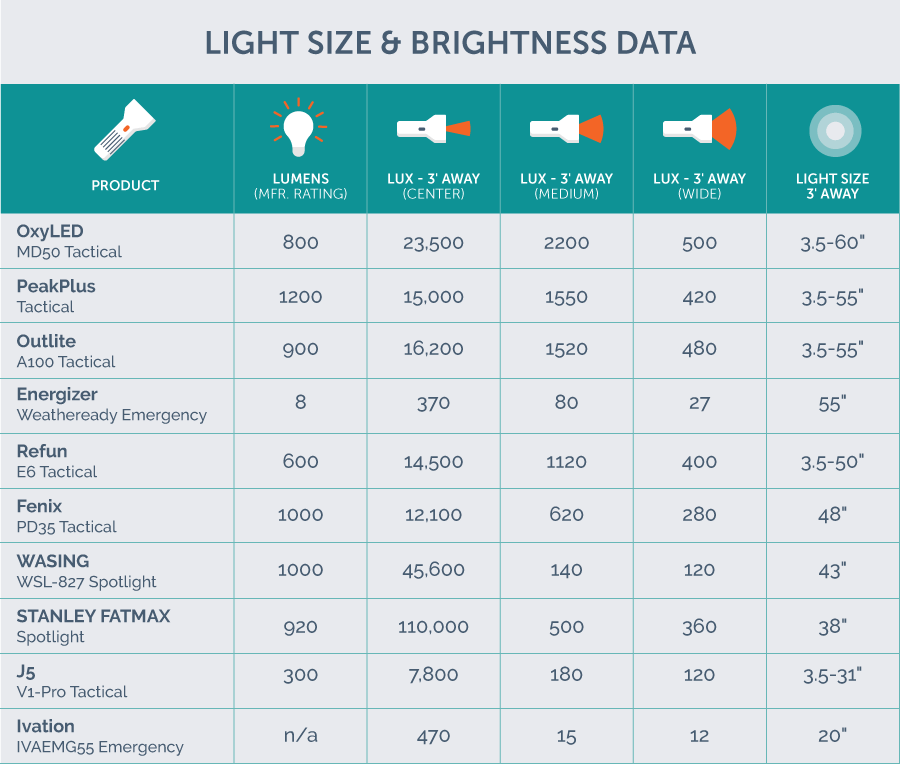
To make sure we are gathering real world results, we are scoring the quality of light based on its lux, a unit of light measurement where the area is also taken to account. This allows us to measure the total “amount” of visible light and the intensity of the illumination on a surface. Lux is also indicative of the light’s throw, which is how far the light will shine before it starts to drop off in illumination. In technical terms, one lux is equal to one lumen per square meter.
For our tests we placed all of the flashlights three feet from the wall. All batteries were fully charged to control as many variables as possible. To start, we held the light meter’s sensor in the center of the beam against the wall to capture the brightest reading. Then we moved the sensor 12” and 24” from center to see how the light diffuses when moving away from the concentrated area.
The zoom featured lights offered some challenges because the brightness and flood are adjustable and are affected by each other. With greater zoom comes a smaller area of light and vice versa. To quantify these variable settings, we recorded the max brightness at full zoom, which created approximately a three inch diameter flood. The zoom was then adjusted to a 30” diameter to measure the medium distance reading. Then finally it was zoomed completely to record the brightness along edges.
The STANLEY FATMAX had the most impressive results in our tests. We expected one of the searchlights to have the highest lux rating due to their large reflector design, but the STANLEY FATMAX stomped the WASING searchlight with over double the lux rating.
Light size

Not only did we measure the quality of light, but we also measured the size of the light, also referred to as “flood.” Some flashlights have even light distribution from edge to edge while others are stronger in the center and are less so along the edges.
The flashlights with the zoom mechanics have flexible yet limiting lighting profiles. Let us explain: the light intensity can be adjusted by pulling out the zoom ring to increase the throw and brightness, but the light narrows as the zoom intensifies. At the highest zoom setting, the light can be awkwardly bright and narrow for some uses. Zooming in all the way might be more ideal to snipe distant objects outdoors.
We ran our test in a controlled environment. All flashlights were placed three feet away from the wall in a dark room. We measured the lux with a light meter and the size of the light with a measuring tape. Of course, the size of the light would increase the further from the wall we go, but this data is more for comparison purposes. The results may appear arbitrary on their own, but see how the stack up to one another to gather context.
The light with the largest light size in our tests was the OxyLED at 60 inches, three feet from the wall — impressive for a relatively small device. We noticed that most of the other tactical flashlights and searchlights weren’t too far behind. The emergency lights show underwhelming results, pumping out a large enough area to watch your step in the dark. Even though the Energizer emergency light has a large light size reading, the brightness outside of dead center is very dim.
Battery
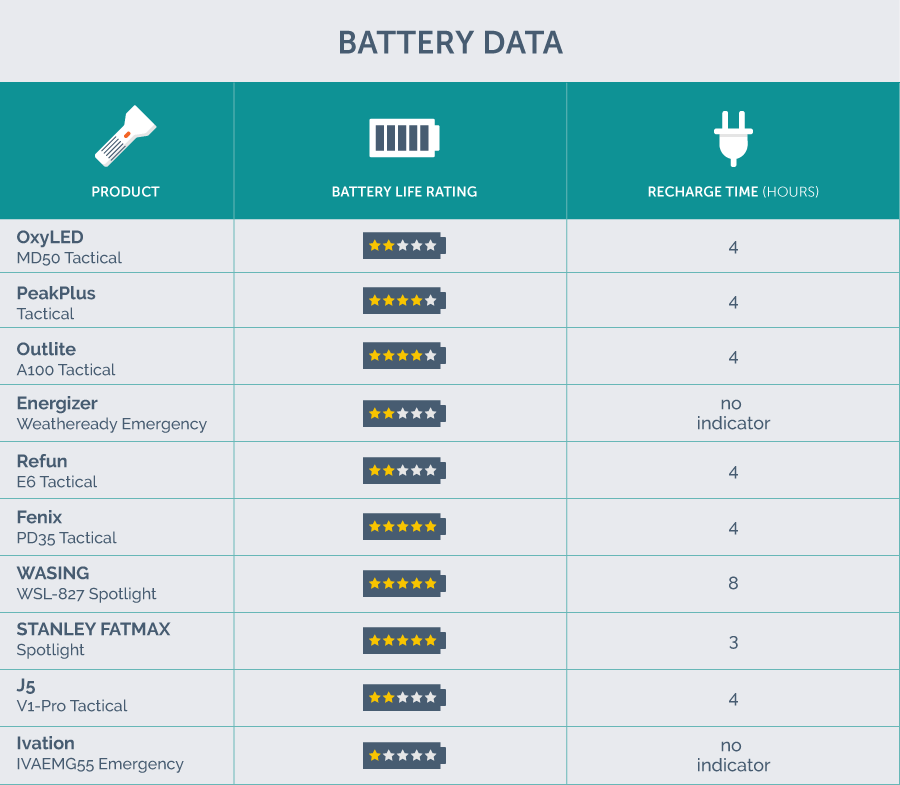
Starting off with a full charge with the stock batteries, we left all the rechargeable flashlights on with their brightest settings. We ran the same test with the lowest setting as well. Battery performance is also highly reliant on the flashlights’ ability to dial down brightness.
Even though the Fenix PD35 can conserve power under its “Eco” mode, this might not be a usable brightness for all users. Since these tests are highly subjective and dependent on varying usage patterns, we ranked the battery performance from one to three stars.
Battery performance will be subjective, but we give highest kudos to the Fenix PD35 because it has the most customizable light settings. You will be able to dial down to your precise needs to stretch out the battery life. The manufacturer advertises 140 hours of light on “eco” mode.
Color temperature
Finally we took note of the color temperature of each light. The closer to daylight white the better. This helps retain the original color of the object(s) we are illuminating, which helps our eyes distinguish what we are seeing. Flashlights with an unnatural color tend to wash out the colors, making it slightly harder to see.
The Fenix PD35 had the most pleasing colors in our tests. Its light is bright with subtle warm tones emulating natural daylight, which stays consistent through its 5 brightness modes.
Best overall: Fenix – PD35

Some would say it was love at first light… the Fenix PD35 is a marriage of great design and performance. Its thoughtful design with a dedicated mode button on the side, small form factor and quality of light, makes the winning argument for the top rechargeable flashlight.
With a slim, sleek and cylindrical form factor, the Fenix PD35 looks like a metal cigar. The lean, straight, barrel design makes it easier to hold and slip into the pocket without an awkward bulge. Its anti-roll design was also much better than the four other tactical lights we tested. Fenix wastes no space and designed the metal body only wide enough to snug in the battery.

Made from an aluminum alloy, this durable material is scratch resistant and can withstand drops and bumps without worry. It is also rated waterproof to IPX-8 standard, meaning it can be underwater up to six and a half feet for 30 minutes. Drop it on the cement or even in a wet puddle, the Fenix PD35 can handle it all.
The quality of light is the Fenix PD35’s strongest feature. It has a bright wide cast with a very gradual brightness drop-off from the center. We found this more usable and convenient than the zoom feature. Even though the Fenix PD35 wasn’t the brightest performer compared to the zoom tactical flashlight at full zoom, its light was the equivalent of every other zoom length in one. The brightness is thick and rich with a natural daylight color.

The dedicated stainless steel side switch is a thoughtful addition. Many flashlights on the market use the tail switch to turn the device on and off and switch between modes (high, low, strobe, etc.). Accessing the different modes with the tail switch requires a half press, then to lock it in place the button must engage all the way until it clicks.
Separating the power and mode switches alleviated the nuances of a halfway vs. full button press. Holding the button for three seconds switches the rechargeable flashlight between outdoor mode and tactical mode. The outdoor mode features all six light settings from high all the way down to economy and strobe. Tactical mode simplifies the light into high, low and strobe, to provide quick access between modes.
Despite all the great things we had to say, this light does have a couple of minor faults worth mentioning. First off, if the flashlight is running on the highest setting for more than a couple minutes on a fully charged battery, it will run warm. More than 5 minutes on high, this device will start getting hot. Ironically the brand is named Fenix. Luckily there are plenty of less intensive modes that still produce great useable light. Secondly, Fenix is featured at the very top of our budget and does not include a rechargeable battery or charger. With that said, the Fenix – PD35 is still our favorite and comes highly recommended.
Key takeaways:
- The Fenix PD35’s frame is constructed with durable aluminum alloy and features strong water resistance.
- Its bright light drops off gradually from the center to allow good illumination to the outer edges.
- A dedicated switch on the side to control light modes offers added convenience.
- Five brightness modes to dial in to precise needs.
- A slim barrel design easily fits into the pocket without bulk.
- The daylight toned light is most pleasing to the eye and represents more natural colors.
The brightest: STANLEY – FATMAX

By far the brightest light we tested was the STANLEY – FATMAX 10W LED Lithium-Ion Rechargeable Spotlight, metering at 110,000 lux at three feet. This rechargeable flashlight has a large reflector and a bright LED to throw the light far into the distance. The foldable stand placed on the top of the light can be pushed out so that the light can be placed upside down and prop against a surface.
The STANLEY – FATMAX operates up to an hour on high and roughly seven hours on low. Curiously, the light has an auto shut-off feature at the one hour mark to help conserve battery and will only allow the user to leave it on high for several seconds. To use the light continuously, you’ll have to switch to the low mode.
The lithium-ion battery technology allows the flashlight to retain a charge up to 12 months without recharging. The built-in battery and AC/DC charging cords make for a hassle free charging experience. Unlike the tactical rechargeable flashlights, you don’t have to disassemble any pieces for charging. It is also possible to leave the charger plugged in and let the light run continuously.
Instead of including a top-side handle like most other searchlights, the STANLEY FATMAX has a pistol grip and trigger. We’re not convinced this was the best design choice, unless you like walking around with a space laser blaster. Even if the grip was comfortable enough to hold, it isn’t as ergonomic to hold a large device outward and away from your body for long periods of time. Top mounted flashlights can be carried at your side, which would be more ideal for walking around. However, the advantage of having a pistol grip searchlight is the ability to point the light exactly where it is needed.
If you need an unapologetically bright light source, this would be the right option for you. The piercing bright light allows it to travel further than the rest. Its rugged design language. makes it a great option for outdoor activities as well.
Stanley advertises their FATMAX line as innovative tools for working professionals, adding extra quality and functionality to classic designs. Even though there weren’t any unique design features in our model, the searchlight outperformed all the other lights in our brightness test.
Key takeaways:
- STANLEY – FATMAX’s pistol grip provides an ergonomic way to hold and point the light into a specific direction.
- The light works with the AC/DC charger plugged in for extended use.
- A foldable stand helps prop up the light to keep your hands free.
- The bright light can travel can easily shine into the distance.
Other finalissts we tested
Ivation emergency light

The Ivation emergency light was the most clever device we tested. In its basic form, the unit serves as a night light when plugged into the wall. When the light is removed from the induction charging cradle, the night light turns off and the opposite end of the light becomes a flashlight. The first time we saw the transition, our inner tech geek got excited. The technology isn’t revolutionary, but it is practical and functional.
The device is made of mostly of plastic with a glossy finish and rounded edges. It doesn’t stack up to any of the tactical flashlights for build quality, but it wasn’t made to bounce off rocks or roll in the dirt. The light can change between three brightness settings, but we found there differences too subtle so we left it on it’s brightest setting. Its light is bright enough for the indoors where the throw doesn’t need to be incredibly far.
Some consumers have reported that the unit is top heavy when placed in the charging cradle against the wall, making the unit lean slightly forward. We did not experience this with our model, but can see how this would happen on wall outlets that aren’t as snug fitting.
Get the most out of the Ivation Emergency light and utilize the night light feature in hallways or bedrooms. We also enjoy that the charging cradle provides a dedicated home for the flashlight, you’ll always know where to find the light when you need it.
WASING searchlight
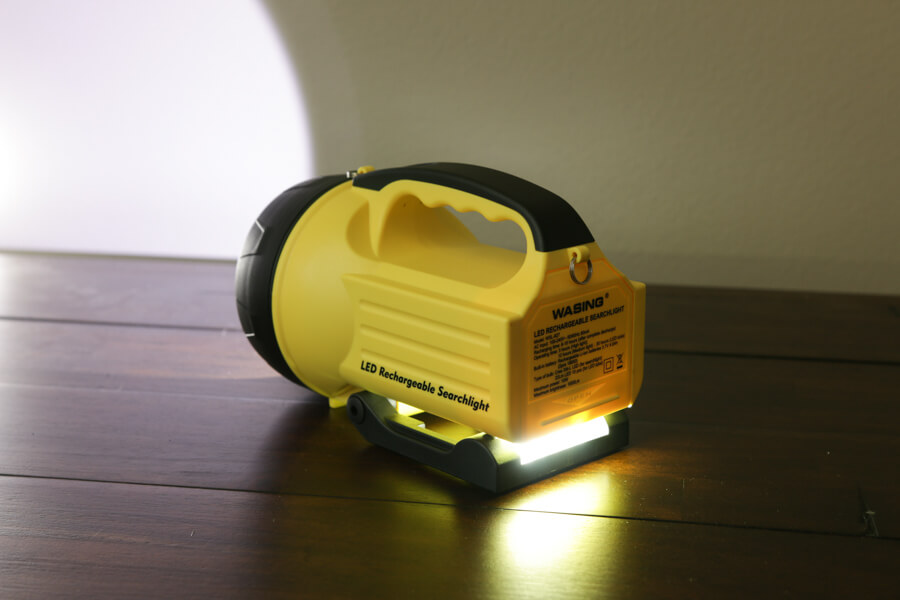
The WASING spotlight sports a classic searchlight design with a large reflector, husky body and top-mounted handle. There is an option to attach a shoulder strap, which could come in handy to loop around a branch or to throw around your shoulder. The two prong charging cable is attached to the device and can be tucked inside the body. No more losing chargers, hallelujah! The light also comes equipped with a foldable stand with a strip of LED’s for a floodlight option.
The WASING Spotlight had the second highest brightest score, but fell short to the STANLEY FATMAX. Their lighting profiles were fairly similar, but the brightness drops off much more dramatically outside of the center circle. The other main difference was build quality. Even though they were both made of plastic, the STANLEY FATMAX felt more premium with the glossy and matte design aesthetic. The WASING also weighed in 1.4 lbs less and felt more like a toy, which might not entirely be a bad thing.
This might not be the brightest nor the most compact light on the market, but the WASING would make a good companion for outdoor activities such as camping. The strip of LED’s on the foldable stand and the attached charging cable are two small features that make it worth a second look over it’s competitors.
Energizer Weatheready emergency light

The Energizer Weatheready LED emergency light is small and budget friendly. The light is designed to automatically turn on when the power goes out. The device is made of mostly plastic and has retractable prongs that can be pulled in for better grip while in use. Unfortunately this flashlight has very low light output and for that reason we have a hard time recommending it.
We would have liked to see this flashlight double as a night light while plugged in. With that said, the Energizer Weatheready flashlight is budget friendly and would answer the call during an emergency.
The rest

Outside of the Fenix PD35, the remaining rechargeable tactical flashlights we tested shared many of the same design languages with one another. The OxyLED and Refun tactical flashlights appear to use the same manufacturer for their parts. All of the metal components from the zoom shaft to the tail switch look the similar, except for subtle differences in dimensions. The same story goes for the PeakPlus and Outlite tactical flashlights. The differences are a little more apparent when examining the placement, shape and color of the reflector, which reflected in the performance.
With the design being so similar in these four models, we chose to only discuss the OxyLED tactical flashlight because it was the brightest and most natural looking light. The Refun, Outlite and Peakplus, all had slightly cooler tones, which became very apparent when shining against white objects. We found these hues undesirable as it makes it a slightly harder to distinguish the items being illuminated.
There is really nothing to gripe about when it comes to build quality. The aircraft aluminum is a proven standard for tactical flashlights and is no different in the OxyLED tactical flashlight. Every click on the tail switch is snappy and responsive. Halfway presses to switch modes are fairly accurate. The zoom mechanics pull out and retract with smooth resistance.
In many respects, the OxyLED tactical flashlight shines a very similar light to the Fenix PD35. The main difference is that the Fenix is able to achieve the brightness of almost all the zooms in one mode. With the zoom mechanic found in all the other flashlights we tested, users must make a decision to have a bright or wide light.
If size is most important to you than look no further than the J5 tactical flashlight. This was the smallest light we tested in the lineup. It is 1.7 inches shorter than the Fenix PD35. Even though it was the least bright of the tactical lights, the amount of illumination is still usable in most scenarios. Build quality is on part with all of the tactical models, even in its petite size. The best part about the J5 tactical flashlight is that it takes the super accessible AA batteries.
The bottom line

Flashlights all perform the same task so design and performance go a long way. We explored several categories, each one trying to distinguish itself with it’s design. Tactical lights embrace its refined reputation with a rugged and compact build. Searchlights opt for ultimate power and hands free usage. Emergency lights are built for convenience and readiness.
Our pick for the best all around rechargeable flashlight is the Fenix PD35 for its quality of light, solid construction, functionality and good looks. It performs with the best of them and makes a great companion as you embark in the dark edges of this earth.
More Reviews
Klarus - XT11GT
LuminoLite
Maxxima - LED Multi-Color
Toro - 51621
AMES - 2519500
Black+Decker - LST136W
Magliner - HMK119UA4
Honda - 21" HRR216K9VKA
Gladiator - Heavy Duty Rack
Topeak - Joe Blow Sport III


